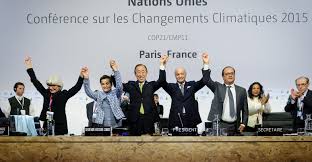A Brief History of Climate Change

Above: World leaders agree a plan to limit average global temperature rise to 1.5ºC above pre-industrial levels in Paris in 2015.
1827 Greenhouse Effect: Jean-Baptiste Fourier suggests the existence of an atmospheric effect keeping the earth warmer than it would otherwise be. He uses the analogy of a greenhouse.
1896 Global Warming: Arrhenius, a Swedish chemist, advances the theory that carbon dioxide emissions from combustion of coal would enhance the earth's greenhouse effect and lead to global warming.
1967 Global Temperature Warning: the first reliable computer simulation calculates that global average temperature may increase by more than 4oC when the atmospheric carbon dioxide level reaches double that of pre-industrial times.
1987 Ice-Core Evidence: An ice core from Antarctica analysed by French and Russian scientists reveals an extremely close correlation between carbon dioxide levels and temperatures going back more than 100,000 years.
1992 Climate Change At Rio Earth Summit: The Framework Convention on Climate Change (FCC), signed by 154 nations in Rio de Janeiro, agrees to prevent ‘dangerous' warming from greenhouse gases and sets an initial target of reducing emissions from industrialised countries to 1990 levels by the year 2000. President George Bush (Senior) signs on behalf of the United States.
2001 Kyoto Protocol: The Kyoto Protocol agrees legally binding emissions cuts for industrialised nations, averaging 5.5%, to be met by 2010.
2005 Kyoto Protocol Signed: 178 countries had signed the Kyoto Protocol by this point.
2005 Kyoto Protocol came into force after at least 55 Parties to the Convention, responsible between them for at least 55% of total carbon dioxide emission in 1990, had agreed the protocol in their own country.
2008: The Climate Change Act sets legally binding targets for the UK to cut its greenhouse gas emissions by at least 80% below 1990 levels by 2050. An independent body, the Committee on Climate Change, is set up to recommend carbon budgets and check the government’s progress against them. This landmark piece of legislation has since provided inspiration for other countries around the world.
2015: The Paris Agreement: Heads of state from 195 countries met to adopt the first-ever universal, legally binding global climate deal. The agreement aims to ensure that global temperature rises are limited to 1.5°C above pre-industrial levels. Ahead of the meeting each country submitted their own action plan to the conference. The Paris Agreement acts as bridge between current policies and climate-neutrality by 2100.
2016: Paris Ratified: The Paris Agreement came into force on 4th November 2016, by which time at least 55 countries, representing at least 55% of global emissions, had ratified, accepted or approved the agreement in their own country.
2019: Many Local Authorities in Derby, Derbyshire, Nottingham and Nottinghamshire declared climate emergencies. The UK Parliament declared a climate emergency. The Climate Change Act of 2008 is updated; instead of aiming for 80% cuts in emissions compared to 1990 levels, we are now aiming for Net Zero Carbon by 2050.
